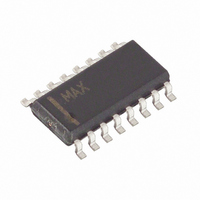MAX1655ESE Maxim Integrated Products, MAX1655ESE Datasheet - Page 23

MAX1655ESE
Manufacturer Part Number
MAX1655ESE
Description
IC CTRLR DCDC PWM STPDWN 16-SOIC
Manufacturer
Maxim Integrated Products
Type
Step-Down (Buck)r
Datasheet
1.MAX1655ESE.pdf
(28 pages)
Specifications of MAX1655ESE
Internal Switch(s)
No
Synchronous Rectifier
Yes
Number Of Outputs
1
Voltage - Output
1 ~ 5.5 V
Current - Output
10A
Frequency - Switching
150kHz, 300kHz
Voltage - Input
4.5 ~ 30 V
Operating Temperature
-40°C ~ 85°C
Mounting Type
Surface Mount
Package / Case
16-SOIC (3.9mm Width)
Power - Output
696mW
Output Voltage
1 V to 5.5 V
Output Current
10 A
Input Voltage
4.5 V to 30 V
Mounting Style
SMD/SMT
Maximum Operating Temperature
+ 85 C
Minimum Operating Temperature
- 40 C
Lead Free Status / RoHS Status
Contains lead / RoHS non-compliant
Available stocks
Company
Part Number
Manufacturer
Quantity
Price
Company:
Part Number:
MAX1655ESE
Manufacturer:
MAXIM
Quantity:
29
Part Number:
MAX1655ESE
Manufacturer:
MAXIM/美信
Quantity:
20 000
A 10mA to 100mA Schottky diode or signal diode such
as a 1N4148 works well for D2 in most applications. If
the input voltage can go below 6V, use a Schottky
diode for slightly improved efficiency and dropout char-
acteristics. Don’t use large power diodes such as
1N5817 or 1N4001, since high junction capacitance
can cause VL to be pumped up to excessive voltages.
The secondary diode in coupled-inductor applications
must withstand high flyback voltages greater than 60V,
which usually rules out most Schottky rectifiers.
Common silicon rectifiers such as the 1N4001 are also
prohibited, as they are far too slow. This often makes
fast silicon rectifiers such as the MURS120 the only
choice. The flyback voltage across the rectifier is relat-
ed to the V
former turns ratio:
where: N is the transformer turns ratio SEC/PRI
Subtract the main output voltage (V
in this equation if the secondary winding is returned to
V
rating must also accommodate any ringing due to leak-
age inductance. D3’s current rating should be at least
twice the DC load current on the secondary output.
Table 4. Low-Voltage Troubleshooting
Sag or droop in V
under step load change
Dropout voltage is too
high (V
V
Unstable—jitters between
two distinct duty factors
Secondary output won’t
support a load
High supply current,
poor efficiency
Won’t start under load or
quits before battery is
completely dead
OUT
IN
decreases)
and not to ground. The diode reverse breakdown
OUT
SYMPTOM
V
V
SEC
OUT
V
FLYBACK
follows V
IN
is the maximum secondary DC output voltage
-V
is the primary (main) output voltage
(Transformer Secondary Diode)
OUT
OUT
______________________________________________________________________________________
IN
= V
difference according to the trans-
as
SEC
Low V
<1V
Low V
<0.5V
Low V
<0.5V
Low V
V
Low input voltage, <5V
Low input voltage, <4.5V
Boost-Supply Diode D2
IN
+ (V
< 1.3 x V
IN
IN
IN
IN
CONDITION
Rectifier Diode D3
IN
-V
-V
-V
-V
OUT
OUT
OUT
OUT
DC-DC Controllers in 16-Pin QSOP
- V
OUT
High-Efficiency, PWM, Step-Down
OUT
OUT
differential,
differential,
differential,
differential,
) from V
(main)
) x N
FLYBACK
Limited inductor-current slew
rate per cycle.
Maximum duty-cycle limits
exceeded.
Normal function of internal low-
dropout circuitry.
Not enough duty cycle left to
initiate forward-mode operation.
Small AC current in primary can’t
store energy for flyback operation.
VL linear regulator is going into
dropout and isn’t providing
good gate-drive levels.
VL output is so low that it hits the
VL UVLO threshold at 4.2V max.
ROOT CAUSE
_____________Low-Voltage Operation
Low input voltages and low input-output differential volt-
ages each require some extra care in the design. Low
absolute input voltages can cause the VL linear regula-
tor to enter dropout, and eventually shut itself off. Low
input voltages relative to the output (low V
ential) can cause bad load regulation in multi-output fly-
back applications. See Transformer Design section.
Finally, low V
output voltage to sag when the load current changes
abruptly. The amplitude of the sag is a function of induc-
tor value and maximum duty factor (D
Characteristics parameter, 98% guaranteed over tem-
perature at f = 150kHz) as follows:
The cure for low-voltage sag is to increase the value of
the output capacitor. For example, at V
= 5V, L = 10µH, f = 150kHz, a total capacitance of
660µF will prevent excessive sag. Note that only the
capacitance requirement is increased and the ESR
requirements don’t change. Therefore, the added
capacitance can be supplied by a low-cost bulk
capacitor in parallel with the normal low-ESR capacitor.
Table 4 summarizes low-voltage operational issues.
V
SAG
= ———————————————
IN
2 x C
-V
OUT
Increase bulk output capacitance per
formula above. Reduce inductor value.
Reduce f to 150kHz. Reduce MOSFET
on-resistance and coil DCR.
Increase the minimum input voltage or
ignore.
Reduce f to 150kHz. Reduce secondary
impedances—use Schottky if possible.
Stack secondary winding on main output.
Use a small 20mA Schottky diode for
boost diode D2. Supply VL from an
external source.
Supply VL from an external source other
than V
OUT
differentials can also cause the
BATT
x (V
(I
STEP
, such as the system 5V supply.
IN(MIN)
)
SOLUTION
2
x L
x D
MAX
MAX
IN
IN
= 5.5V, V
-V
an Electrical
- V
OUT
OUT
differ-
)
OUT
23










